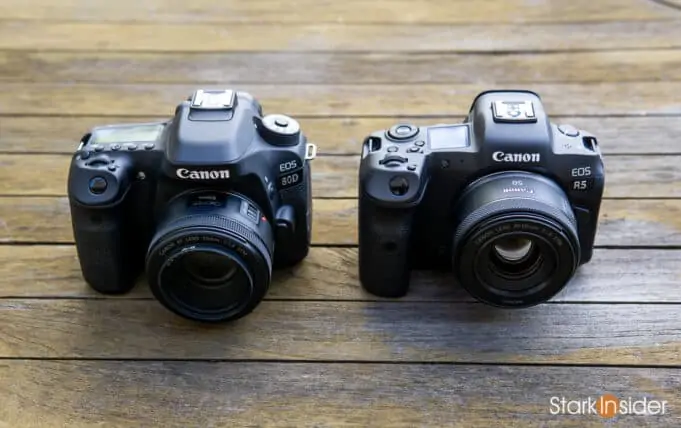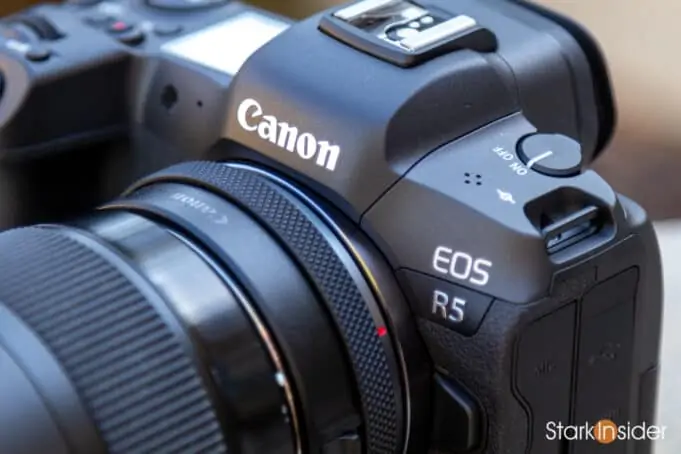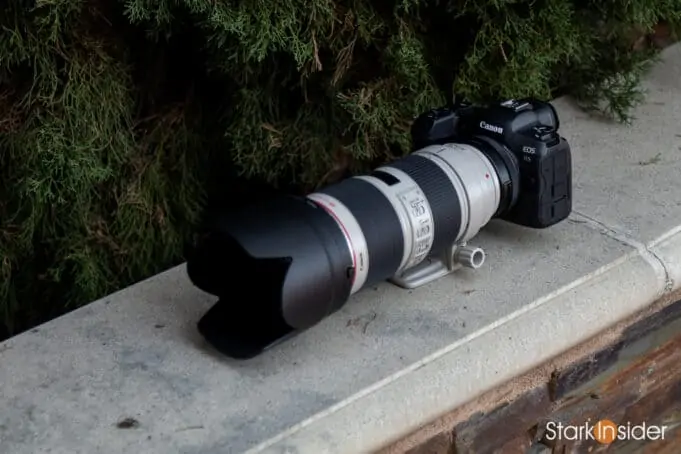Some initial impressions by Clinton Stark on the new mirrorless flagship Canon EOS R5.
For the longest time the internet cried out loud for Canon to innovate. After all Sony had jumped into mirrorless long before and Canon was slow to transition from DSLR.
Finally in 2018 that changed. With the EOS R Canon began to slowly roll out a new “R” line of Canon mirrorless bodies featuring a new “RF” mount (incompatible with Canon EF/EF-S lenses without using an adapter).
But users wanted a flagship mirrorless — a 5D Mark IV for the 21st century.
Canon responded, in a big way, last summer with the brand new R5. With a 45MP and up to 8K video with C-Log this body appeared to be a no-compromise kingmaker. Indeed its specs bested pretty much anything in the market including top models from Sony and Panasonic.
R5 stock was initially hard to come by, thanks to the pandemic, but now inventory seems to be more readily available and since its been in the hands of many people I wanted to circle back and see what the general review consensus has been and also add some of my own thoughts as an owner.
Is the R5 all that its cracked up to be?
Yes… and no.
There’s definitely a grey area here. The old “it depends” of sorts.
Regardless, if you’re shopping for a flagship mirrorless camera the R5 should be on your shortlist (along with the Sony A7 range including the new and pricey A1), but you should at least be aware of its strengths and weaknesses.
Canon EOS R5: What the reviews are saying
When it comes to camera reviews the most authoritative voice these days is DP Review (Digital Photography Review). If I were researching the R5 and hemming and hawing about making a purchase I’d start with the DP Review Canon EOS R5 review. In summary:
In the end, is the EOS R5 the true mirrorless successor to the EOS 5D series of DSLR cameras? Yes. Absolutely. It’s not necessarily the default choice of today’s high-end mirrorless market, but if that’s a market you find yourself in, this camera is absolutely worth a close look.
Interestingly Richard Butler says that even in absence of the 8K video the R5 would still be the “most well-rounded high-resolution mirrorless camera on the market”
And speaking of video, here is the constant complaint about the R5 as seen in the DPReview summary:
- the R5 overheats during long video recording times in 8K mode
This is a common issue cited in review after review.
Tech blog Engadget just posted its R5 review (87 out of 100) and there too the reviewer notes “video overheating issues” as a con.
But still recommends it for the right buyer:
For other types of projects, shot mostly at or below 4K 30 fps with occasional 8K or high-frame-rate shooting, I’d personally buy this camera if I could afford it. The latest updates have reduced the overheating issues, it offers numerous other benefits for video shooting and is a great camera for photography.
Canon EOS R5: What about the quality of the sensor?
DXOmark tends to be a decent resource for evaluating the quality of a camera sensor (that also includes smartphones). What do they say about the Canon EOS R5 sensor?
With a DXOMARK sensor rating of 95 points, the Canon EOS R5 has a highly responsive sensor. Its score places it in 16th position in our database of full-frame and MF sensors overall; in 14th place for full-frame 35mm cameras; and in 1st place for Canon sensors.
Pretty good — in fact, “a high water mark” even. The R5 features Canon’s best sensor to date per DXOmark and currently sits 14th overall in its category relative to the competition.
Other noteworthy cameras worth comparing include the Sony A7R III and IV, Nikon D850 and Z7, and the Panasonic S1R. All of these are high resolution flagship bodies with high pixel counts.
Canon EOS R5: My early thoughts using it for oil painting archiving photography

I’ve had my R5 for only a few months now. Though I’ve shot video here on Stark Insider for about 16 years now (with a variety of bodes over the years including various Canon EOS DSLR bodies such as the 80D and 90D, the Canon C100 II, RED Dragon, and Panasonic GH5), this camera had a different mission.
My goal was to catalog Loni Stark’s artwork, mostly oil paintings. So in this case video features were less important.
Instead I wanted a high resolution sensor so that we could create prints when and if needed, and also maintain a nice high quality RAW file for archiving. The older Canon 80D was fine, but resolution was lacking, and zooming in revealed deficiencies in detail. Loni’s older Sony a6000 was fine too, but its shortcomings revealed themselves in color accuracy (not good).
So I set out to find and buy a true hybrid mirrorless camera, one that emphasized photo specs first.
Hence, the Canon EOS R5.
Being historically a Canon shooter almost all my glass is EF mount. So it made sense to stick with the Canon system and use a EF/RF adapter (works great) with the R5 so I can tap into all that choice.
ALSO SEE: Top 10: Best DSLR & Mirrorless Cameras (January 2021)
My experience so far with the R5?
Absolutely outstanding. At least for photography to this point. I have yet to shoot a video project for Stark Insider using the R5… yet. Coming soon.
As you’d expect the controls are readily familiar for Canon shooters. The interface fast and responsive. Auto-focus is wicked good. Handling too is top notch. Pretty much all the Canon hallmarks are here, only in a shrunken mirrorless design.
Image wise I have zero complaints.
With Panasonic and Sony I typically have to fiddle with all sorts of secondary color correction in Adobe Lightroom when post-processing Loni’s work. Some colors like peach or orange are really hard apparently to get right. So I tweak. And forget about the iPhone — it’s designed to make people look beautiful on social media, piling on saturation and contrast and artificial sharpening and all sorts of other software processing chicanery. It’s fine for a quick rough shot of a canvas to share on Instagram or Facebook, but really not a good solution for archiving and large scale print reproduction.
With the R5, however, I find myself needed to tweak color less often. Yes, on occasion I still need to make adjustments. But out-of-the-camera files are almost spot on when it comes to color rendering. It helps too that we recently added a pair of (excellent) Dracast LED panels to the studio. Now we can expose the room in clean 5500K light when needed.
So, yes, my use case is a little bit different. I’m not a YouTuber or social media influencer or brand ambassador (and I’m not so sure the R5 is a good fit for those users). Instead Loni and I are just taking old fashioned photos of artwork and archiving them to a hard drive, and also using them to create physical reproductions when needed or to post to her online store at Atelier Stark.
For us so far the R5 is a great tool.
Note: photo above of painting is highly compressed, for illustration only.
Canon EOS R5: Downsides

I’d be remiss not to mention a few of the things I don’t like about the R5.
Overheating in 8K video issue aside, here’s some minor niggles:
- Aesthetically I don’t like the silver hot shoe — why not finish that in black to match the body? Very minor complaint to be sure, but it bugs me, especially for such an expensive flagship camera.
- HDMI port is micro instead of full-size. Understand space is an issue, still it would’ve been nice to see the full size port here.
- Lack of custom buttons — by comparison the Panasonic GH5 has lots of custom buttons you can customize (for instance, I configured the one on the front that falls under my right index finger to toggle the waveform monitor overlay), but with the R5 there just doesn’t seem to be as many opportunities. I think that’s mostly okay when it comes to photos, but rather limiting when setting up the camera for video projects.
- And finally… the user interface. Yes, it’s perfectly usable. Fast. Responsive. And menus are Canon standard so they’re easy to navigate. It’s just that it’s 2021, and Canon and pretty much all other camera manufacturers aside from Blackmagic need to re-tool the UI to modern sensibilities. We’ve been using smartphones for about 13 years now and have seen what well designed apps look like and how they make interactions so enjoyable. Meantime, camera menu systems are stuck in a bland, vast deep sea of horizontal and vertical text. For the most part. In any case this is not a R5 specific nit, rather something I’d like to see the overall industry improve.
Finally a parting thought on that R5 overheating thing. Once again my fine investigative skills have turned up yet another undeniable truism. That is: the more inanely and loudly someone complains on the internet about this particular camera overheating (no less while shooting boatloads of 8K video which we all do right?? right??) the less creative that particular person is. Just a fact I’ve discovered. Hey, it’s easier I guess to complain than it is to create.
TL;DR the R5 negatives: thankfully, no show-stoppers yet that I’ve experienced.
Canon EOS R5: Is it worth it?
If you’re a former EOS 5D owner than the answer as to whether this camera is worth it for you is probably yes. With the Canon EOS R5 you basically get 5D-like performance, but with all the modern features you’d want to go at least another 10 years, including a full-frame 45MP sensor and mirrorless body.
If you’re a video shooter I’m not so sure. And also I’m not so sure why every camera body has to be force fit into video-centric applications. Why? Some cameras are better for photography. Some for video. And some for a bit of both. Find the right tool for the job. For video at 4K I think the R5 makes a good “b” option. Or for those who primarily shoot photos, but need some high quality video on the side (C-Log gives lots of latitude in post): for photojournalists, landscape shooters, fashion photography and for similar applications I think the R5 is worth consideration. If you’re an indie filmmaker, shooting wedding videos, short films and music videos and corporate work, I’d look elsewhere. For instance, why not instead consider a dedicated video camera, like the Canon C70 or Sony FX6 or a Blackmagic URSA/Pocket or RED Komodo?
MORE: Canon DSLR & mirrorless articles by Clinton Stark
If you want a high performance camera that does a little bit of everything extremely well, the R5 makes a strong case. Thanks to the new RF mount you can expect to adapt this camera to a variety of circumstances and know that the mount itself will be supported for decades to come.
At $3,899 USD the R5 is not a budget option to be sure. Then again it was never intended to be one. This is a Canon flagship camera and is priced similarly to its forebear, the EOS 5D Mark IV.
In my initial use and experience I think Canon got it right.
The R5 brings a lot to the table. It’s as if Canon took all its greatest hits and technical know-how and shoehorned it (somehow) into a compact body. Impressive to be sure. And a strong consideration for those looking to spring into full-frame mirrorless. Just be sure you’re keenly aware of its limitations when it comes to video — they may or may not matter depending on the job.
Happy shooting!




